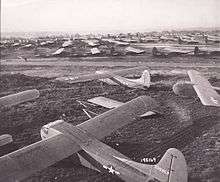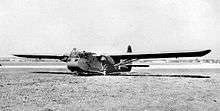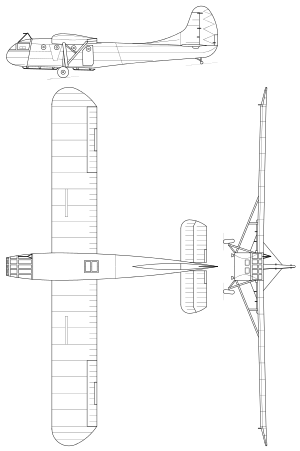Waco CG-4
| CG-4A | |
|---|---|
| | |
| CG-4A | |
| Role | Military glider |
| Manufacturer | Waco Aircraft Company |
| First flight | 1942 |
| Primary users | United States Army Air Forces Royal Air Force Royal Canadian Air Force United States Navy |
| Number built | >13,903 |
| Variants | Waco CG-15 |
The Waco CG-4A was the most widely used United States troop/cargo military glider of World War II. It was designated the CG-4A by the United States Army Air Forces,[1] and named Hadrian (after the Roman emperor) in British military service.
Designed by the Waco Aircraft Company, flight testing began in May 1942, and eventually more than 13,900 CG-4As were delivered.
Design and development
The CG-4A was constructed of fabric-covered wood and metal and was crewed by a pilot and copilot. It had two fixed mainwheels and a tailwheel.
The CG-4A could carry 13 troops and their equipment. Cargo loads could be a 1⁄4ton truck (i.e. a Jeep), a 75 mm howitzer, or a 1⁄4ton trailer, loaded through the upward-hinged nose section. C-47s were usually used as tow aircraft. A few C-46 tugs were used during and after Operation Plunder.
The USAAF CG-4A tow line was 11⁄16-inch-diameter (17 mm) nylon, 350 feet (107 m) long. The CG-4A pickup line was 15⁄16inch- (24 mm)-diameter nylon, but only 225 ft (69 m) long including the doubled loop.
In effort to identify areas where strategic materials could be reduced, a single XCG-4B was built at the Timm Aircraft Corporation using wood for the main structure.[2]
Production
From 1942-1945, the Ford Motor Company's Kingsford plant built 4,190 Model CG-4A gliders for use in combat operations during World War II. The Kingsford plant built more CG-4A gliders than any other company in the nation at much less cost than other manufacturers. The primary builders of the Model CG-4A gliders were located in Troy, Ohio; Greenville, Michigan; Astoria, New York; Kansas City, Missouri; St. Paul, Minnesota; and Kingsford, Michigan.
The 16 companies that were prime contractors for manufacturing the CG-4A were:
- Babcock Aircraft Company of DeLand, Florida (60 at $51,000 each) [3]
- Cessna Aircraft Company of Wichita, Kansas (750) The entire order was subcontracted to Boeing Aircraft Company's new Wichita plant.
- Commonwealth Aircraft of Kansas City (1,470)
- Ford Motor Company of Kingsford, Michigan (4,190 units at $14,891 each)
- G&A Aircraft of Willow Grove, PA (627)
- General Aircraft Corporation of Astoria, L.I.,NY (1,112)
- Gibson Refrigerator of Greenville, Michigan (1,078)
- Laister-Kauffman Corporation of St. Louis, Missouri (310)
- National Aircraft Corp. of Elwood, IN (one, at an astronomical $1,741,809)[4]
- Northwestern Aeronautical Corporation of Minneapolis (1,510)
- Pratt-Read of Deep River, Connecticut (956)
- Ridgefield Manufacturing Company of Ridgeville, New Jersey (156)
- Robertson Aircraft Corporation of St. Louis (170)
- Timm Aircraft Company of Van Nuys, California (434)
- Waco Aircraft Company of Troy (999 units at $19,367 each)[5]
- Ward Furniture Company of Fort Smith, Arkansas (7)[6][7][8]
The factories ran 24-hour shifts to build the gliders. One night-shift worker in the Wicks Aircraft Company factory in Kansas City wrote,
| “ | On one side of the huge bricked-in room is a fan running, on the other a cascade of water to keep the air from becoming too saturated with paint. The men man the paint sprayers covering the huge wings of the glider with the Khaki or Blue and finishing it off with that thrilling white star enclosed in a blue circle that is winging its way around the world for victory ...
The wings are first covered with a canvas fabric stretched on like wallpaper over plywood then every seam, hold, open place, closed place, and edge is taped down with the all adhesive dope that not only makes the wings airtight, but covers my hands, my slacks, my eyebrows, my hair, and my tools with a fast-drying coat that peels off like nail polish or rubs off with a thinner that burns like Hell.[9] |
” |
Operational history


Whiteman Air Force Base was originally activated on 6 August 1942 as Sedalia Glider Base. In November 1942 the installation became Sedalia Army Air Field and was assigned to the 12th Troop Carrier Command of the United States Army Air Forces. The field served as a training site for glider pilots and paratroopers. Assigned aircraft included the CG-4A glider, Curtiss C-46 Commando, and Douglas C-47 Skytrain. The C-46 was not used as a glider tug in combat, however, until Operation Plunder (the crossing of the Rhine) in March 1945.
CG-4As went into operation in July 1943 during the Allied invasion of Sicily. They were flown 450 miles across the Mediterranean from North Africa for the night-time assaults such as Operation Ladbrooke. Inexperience and poor conditions contributed to the heavy losses. They participated in the American airborne landings in Normandy on 6 June 1944, and in other important airborne operations in Europe and in the China Burma India Theater. Although not the intention of the Army Air Forces, gliders were generally considered expendable by high-ranking European theater officers and combat personnel and were abandoned or destroyed after landing. While equipment and methods for extracting flyable gliders were developed and delivered to Europe, half of that equipment was rendered unavailable by certain higher-ranked officers. Despite this lack of support for the recovery system, several gliders were recovered from Normandy and even more from Operation Market Garden in the Netherlands and Wesel, Germany.
The CG-4A found favor where its small size was a benefit. The larger British Airspeed Horsa could carry more troopers (seating for 28 or a jeep or an anti-tank gun), and the British General Aircraft Hamilcar could carry 7 tons (enough for a light tank), but the CG-4A could land in smaller spaces. In addition, by using a fairly simple grapple system, an in-flight C-47 equipped with a tail hook and rope braking drum could "pick up" a CG-4A waiting on the ground.[10] The system was used in the 1945 high-elevation rescue of the survivors of the Gremlin Special 1945 crash, in a mountain valley of New Guinea.[11]
The CG-4A was also used to send supplies to partisans in Yugoslavia.
After World War II ended, most of the remaining CG-4As were declared surplus and almost all were sold. Many were bought for the wood in the large shipping boxes. Others were bought for conversion to towed camping homes with the wing and tail end cut off and being towed by the rear section and others sold for hunting cabins and lake side vacation cabins.
The last known use of the CG-4A was in the early 1950s by the USAF with an Arctic detachment aiding scientific research. The CG-4As were used for getting personnel down to, and up from, floating ice floes, with the glider being towed out, released for landing, and then picked up later by the same type of aircraft, using the hook and line method developed during World War II. The only modification to the CG-4A was the fitting of wide skis in place of the landing gear for landing on the Arctic ice floes.[12]
Variants


- XCG-4
- Prototypes, two built, plus one stress test article
- CG-4A
- Main Production variant, survivors became G-4A in 1948, 13,903 built by 16 contractors
- XCG-4B
- One Timm-built CG-4A with a plywood structure
- XPG-1
- One CG-4A converted with two Franklin 6AC-298-N3 engines by Northwestern
- XPG-2
- One CG-4A converted with two 175 hp (130 kW) Ranger L-440-1 engines by Ridgefield
- XPG-2A
- Two articles: XPG-2 engines changed to 200 hp (150 kW) plus one CG-4A converted also with 200 hp (150 kW) engines
- PG-2A
- Production PG-2A with two 200 hp (150 kW) L-440-7s, redesignated G-2A in 1948, 10 built by Northwestern
- XPG-2B
- Cancelled variant with two R-775-9 engines
- LRW-1
- CG-4A transferred to the United States Navy (13 units)
- G-2A
- PG-2A re-designated in 1948
- G-4A
- CG-4A re-designated in 1948
- G-4C
- G-4A with different tow-bar, 35 conversions
- Hadrian Mk.I
- Royal Air Force designation for the CG-4A, 25 delivered
- Hadrian Mk.II
- Royal Air Force designation for the CG-4A with equipment changes
Operators

- Czechoslovakian Air Force operated 2 or 3 Wacos, designated NK-4
Accidents and incidents
- 1 August 1943: CG-4A-RO 42-78839, built by contractor Robertson Aircraft Corporation,[13] loses its right wing and plummets to earth immediately after release by a tow airplane over Lambert Field, St. Louis, Missouri, USA. Several thousand spectators had gathered for the first public demonstration of the St. Louis-built glider, which was flown by 2 USAAF crewmen and carried St. Louis mayor William D. Becker, Robertson Aircraft co-founder Maj. William B. Robertson, and 6 other VIP passengers; all 10 occupants perished in the crash.[14] The accident is attributed to the failure of a defective wing strut fitting that had been provided by a subcontractor; the post-crash investigation indicts Robertson Aircraft for lax quality control, and several inspectors are relieved of duty.[13]
Surviving aircraft


- Fagen Fighters World War II Museum, Granite Falls, Minnesota [15]
- Menominee Range Historical Foundation, Iron Mountain, Michigan
- U.S. Army Airborne & Special Operations Museum, Fayetteville, North Carolina
- The Fighting Falcon Museum, Greenville MI[16]
- Kalamazoo Air Zoo, Kalamazoo, Michigan
- National Museum of the United States Air Force, Wright-Patterson AFB, Ohio - AAF Ser. No. 45-27548
- National Infantry Museum, Fort Benning, Columbus, Georgia
- 82nd Airborne Division War Memorial Museum, Fort Bragg, Fayetteville, North Carolina
- Air Mobility Command Museum, Dover AFB, Delaware - AAF Ser. No. 45-15009[17]
- Carolinas Aviation Museum, Charlotte Douglas International Airport, Charlotte, North Carolina
- National Soaring Museum
- Musée Airborne
- Silent Wings Museum, Lubbock, Texas
- Cumbria's Museum of Military Life, Carlisle Castle, Carlisle, Cumbria, UK.
- Museum of Army Flying, Middle Wallop, United Kingdom
- Don F. Pratt Memorial Museum, Fort Campbell, Kentucky
- Airborne D-Day Museum, St. Mere Eglise, Normandy, France
- Cradle of Aviation Museum, Long Island, New York
- Yanks Air Museum, Chino, California
- Museum bevrijdende vleugels, Best, the Netherlands[18][19]
- Pima Air & Space Museum, adjacent to Davis-Monthan AFB in Tucson, Arizona - AAF Ser. No. 45-14647
Specifications (CG-4A)

Data from Aviation Enthusiasts Corner[20] and Pilot's Flight Operating Instructions for Army Model CG4A Glider (TO No. 09-40CA-1)[21]
General characteristics
- Crew: two pilots
- Capacity: 13 troops, or quarter-ton truck (Jeep) and 4 troopers, or 6 litters
- Length: 48 ft 8 in (14.8 m)
- Wingspan: 83 ft 8 in (25.5 m)
- Height: 15 ft 4 in (4.7 m)
- Wing area: 900 ft² (83.6 m²)
- Empty weight: 3,900 lb (1,769 kg)
- Loaded weight: 7,500 lb (3,402 kg)
- Useful load:
- "Troop Carrier (2 crew & 13 passengers): 4,197 pounds (1,904 kg)";
- "Cargo Carrier - Jeep (2 crew, 4 passengers, 1 Jeep Car): 4,197 pounds (1,904 kg)"
- "Cargo Carrier - 75 MM howitzer (2 crew, 3 passengers, 1 Howitzer, 18 rounds ammunition): 4,197 pounds (1,904 kg)[22] ()
- Max. takeoff weight: 7,500 lb (3,402 kg)
- Max take off (Emergency Load): 9,000 lb (4,082 kg)
Performance
- Never exceed speed: 150 mph IAS [N 1] (241 km/h)
- Maximum speed: 150 mph CAS[N 2] (240 km/h CAS[23]) at 7,500 pounds (3,400 kg) 128 mph (206 km/h) CAS/135 mph (217 km/h) IAS at 9,000 pounds (4,100 kg)
- Cruise speed: IAS 72.6 mph[N 3] (117 km/h[N 4])
- Stall speed: 49 mph[N 5] (79 km/h[N 6]) with design load 7,500 lb (3,400 kg)
- Wing loading: 8.33 lb/ft² (40.7 kg/m²
- Rate of sink: About 400 ft/min (2 m/s) at tactical glide speed (IAS 60 mph, 96 km/h)
- Landing run: 600-800 feet (180-244 m) for normal three-point landing; "Landing rolls of approximately 2,000 to 3,000 feet (610 to 910 m) are to be expected at the higher emergency gross weights...")
Armament
none
See also
- Related development
- Aircraft of comparable role, configuration and era
- Airspeed Horsa
- DFS 230
- General Aircraft Hamilcar
- General Aircraft Hotspur
- Gotha Go 242
- Schweizer cargo glider designs
- Slingsby Hengist
- Related lists
References
Notes
Citations
- ↑ Fitzsimons 1978, p. 1199.
- ↑ "WACO CG-4A glider information." World War II Glider and Military Museum. Retrieved: 30 May 2015.
- ↑ Jackson, David D."WWII US glider manufacturing sites." Warbirds and Airshows. Retrieved: 30 May 2015.
- ↑ Diehl 2002, p. 81.
- ↑ Bednarek, Janet Rose Daly and Michael H. Bednarek. Dreams of Flight: General Aviation in the United States.
- ↑ Andrade 1979, p. 96.
- ↑ "Waco CG-4." Fiddler's Green/ Retrieved; 29 March 2012.
- ↑ "Waco CG-4." niehorster.orbat.com. Retrieved; 29 March 2012.
- ↑ Raph, Jane Beasley. "My Aunt the Doper: "Gliding Gladys" in the War Factory." Phlepsinc.com. Retrieved: 29 March 2012.
- ↑ "Silent Partner of the Plane." Popular Science, February 1944, p. 98.
- ↑ "Glider rescue from New Guinea Shangril-la." The Sydney Morning Herald, 2 July 1945.
- ↑ "Ice Cube Airport." Popular Mechanics, September 1952, p. 137.
- 1 2 Gero 2010, pp. 24-25.
- ↑ Associated Press, "Mayor and 9 Die in St. Louis Glider Crash", The Dallas Morning News, Dallas, Texas, Monday 2 August 1943, Number 306, page 1.
- ↑ "Waco CG-4A." Fagen Fighters World War II Museum]. Retrieved: 30 May 2015.
- ↑ "Waco CG-4." The Fighting Falcon Museum. Retrieved: 29 March 2012.
- ↑ "CG-4A." Air Mobility Command Museum. Retrieved: 11 April 2015.
- ↑ Munson, J. "Sailplanes in Our Collection." The Soaring Museum. Retrieved: 29 March 2012.
- ↑ "Waco CG-4." The Airborne Museum. Retrieved: 29 March 2012.
- ↑ Waco CG-4A 'Hadrian'
- ↑ Pilot's Flight Operating Instructions for Army Model CG4A Glider (TO No. 09-40CA-1).
- ↑ Erection and Maintenance Instructions CG-4A Glider (TO No. 09-40CA-2), 15 February 1943.
- ↑
- IAS about 254 km/h
Bibliography
- AAF Manual No. 50-17, Pilot Training Manual for the CG-4A Glider. US Government, 1945, select pages available on Wikimedia Commons, Category:Waco CG-4.
- AAF TO NO. 09-40CA-1, Pilot's Flight Operating Instructions for Army Model CG-4A Glider, British Model Hadrian.US Government, 1944, available on Wikimedia Commons, Category:Waco CG-4.
- Andrade, John M. U.S. Military Aircraft Designations and Serials since 1909. Earl Shilton, Leister, UK: Midland Counties Publications, 1979. ISBN 0-904597-22-9.
- Diehl, Alan E., PhD. Silent Knights: Blowing the Whistle on Military Accidents and Their Cover-ups. Dulles, Virginia: Brassey's, Inc., 2002. ISBN 1-57488-412-3.
- Fitzsimons, Bernard, ed. "Waco CG-4A." Illustrated Encyclopedia of 20th Century Weapons and Warfare, Volume 11. London: Phoebus, 1978. ISBN 978-0-241-10864-2.
- Gero, David B. Military Aviation Disasters: Significant Losses Since 1908. Sparkford, Yoevil, Somerset, UK: Haynes Publishing, 2010, ISBN 978-1-84425-645-7.
- Masters, Charles J., Glidermen of Neptune: The American D-Day Glider Attack Carbondale, Illinois: Southern Illinois University Press, 1995. ISBN 978-0-809-32008-0.
External links
| Wikimedia Commons has media related to Waco CG-4. |
- 3D-model of Waco CG-4
- "Silent Partner of the Plane." Popular Science, February 1944, pp. 94-101. First large article on CG-4A published during World War II; rare photos and drawings
- "Glider Parade" Popular Mechanics,August 1944, pp. 14–15.
- The Assault Glider Trust
- Silent Wings Museum
- U.S. Army Airborne and Special Operations Museum, World War II CG-4A Glider Exhibit, Fort Bragg NC
- Detailed photos of the CG-4A in the National Soaring Museum
- More detailed photos of the CG-4A in the National Soaring Museum, including manual pages
- National WWII Glider Pilots Association, Inc.
| ||||||||||||||||||
| ||||||||||||||||||||||||||
| ||||||